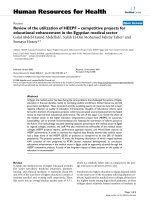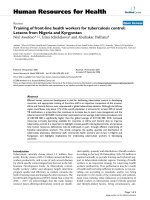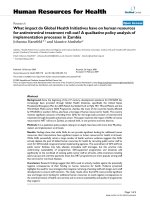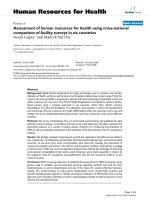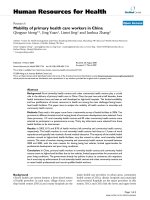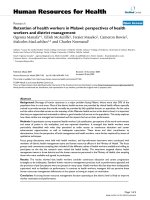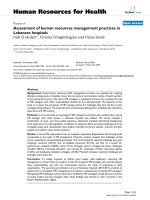Báo cáo sinh học: " Usefulness of Herpes Consensus PCR methodology to routine diagnostic testing for herpesviruses infections in clinical specimens" docx
Bạn đang xem bản rút gọn của tài liệu. Xem và tải ngay bản đầy đủ của tài liệu tại đây (212.87 KB, 4 trang )
BioMed Central
Page 1 of 4
(page number not for citation purposes)
Virology Journal
Open Access
Short report
Usefulness of Herpes Consensus PCR methodology to routine
diagnostic testing for herpesviruses infections in clinical specimens
Georgia Vrioni*
1
, Christos Kalogeropoulos
2
, Constantina Gartzonika
1
,
Efthalia Priavali
1
and Stamatina Levidiotou
1
Address:
1
Department of Microbiology, Medical School, University of Ioannina, Greece and
2
Department of Ophthalmology, University Eye Clinic
of Ioannina, Greece
Email: Georgia Vrioni* - ; Christos Kalogeropoulos - ; Constantina Gartzonika - ;
Efthalia Priavali - ; Stamatina Levidiotou -
* Corresponding author
Abstract
The purposes of the study were to assess the usefulness of simultaneously amplifying herpes
simplex virus 1 and 2, varicella-zoster virus, cytomegalovirus, Epstein-Barr virus and human
herpesvirus 6 DNA in various clinical specimens and to analyze clinical events in patients presenting
positive results. A total of 763 clinical samples obtained from 758 patients, including 115
cerebrospinal fluids, 102 aqueous fluids, 445 swabs from genital (152), oro-facial (138) and other
(155) skin lesions, 96 eye swabs and 5 bronchoalveolar lavages, were tested by using the Consensus
polymerase chain reaction methodology. The clinical files of the patients were consulted
retrospectively. 171 of the 758 patients (22.5%) were positive for at least one of the six target
viruses: herpes simplex virus 1 (n = 95), varicella-zoster virus (n = 40), herpes simplex virus 2 (n =
21), herpes simplex virus 1 plus herpes simplex virus 2 (n = 8), cytomegalovirus (n = 4), Epstein-
Barr virus (n = 1), human herpesvirus 6 (n = 1), and herpes simplex virus 1 plus human herpesvirus
6 (n = 1). The Consensus methodology enabled the rapid and accurate detection of herpesviruses
in various clinical specimens and provided a reliable tool in the diagnosis of herpetic infections.
Findings
Molecular assays based on PCR have become an impor-
tant tool for the detection of various herpes virus DNA in
clinical specimens [1-5]. Since clinical features of herpetic
infections are often not specific and cannot distinguish
between the different viruses, amplification systems that
allow simultaneous detection of different herpesviruses,
have become available [6-8]. The Herpes Consensus PCR
methodology (Argene Biosoft, Varilhes, France) uses "stair
primers" [9] in which the primer sequences are based on
consensus sequences in the DNA polymerase gene of her-
pesviruses and thus allows the simultaneous detection of
the six most frequently encountered viruses – herpes sim-
plex virus 1 and 2 (HSV-1, HSV-2), varicella-zoster virus
(VZV), cytomegalovirus (CMV), Epstein-Barr virus (EBV)
and human herpesvirus 6 (HHV-6)- by a single PCR [10].
The purpose of this study was to report our experience
over the last four years in the detection of the six most
common herpesviruses in various clinical specimens by
using Consensus PCR methodology and to investigate the
correlation between the results obtained with this tech-
nique and clinical data.
Published: 12 June 2007
Virology Journal 2007, 4:59 doi:10.1186/1743-422X-4-59
Received: 5 December 2006
Accepted: 12 June 2007
This article is available from: />© 2007 Vrioni et al; licensee BioMed Central Ltd.
This is an Open Access article distributed under the terms of the Creative Commons Attribution License ( />),
which permits unrestricted use, distribution, and reproduction in any medium, provided the original work is properly cited.
Virology Journal 2007, 4:59 />Page 2 of 4
(page number not for citation purposes)
A total of 763 specimens [115 cerebrospinal fluids (CSF),
102 aqueous fluids, 152 genital swabs, 155 skin swabs,
138 oro-facial swabs, 96 eye swabs and 5 bronchoalveolar
lavages (BAL)] from 758 patients with a range of clinical
presentations that included central nervous system (CNS)
herpesvirus-associated clinical signs such us fever with
acute behavioral disturbances, seizures and focal neuro-
logical signs; keratitis or/and conjunctivitis, uveitis (pre-
sented in the majority of cases as iridocyclitis) and
retinitis, regarding ocular manifestations; genital, oral, or
skin lesions and pneumonitis. All CSF samples were tested
for biochemical analysis (the concentration of protein
and glucose and lymphocyte count) and bacterial infec-
tion (by culturing). Moreover, CSF samples showed nor-
mal glucose level and proved negative when cultured for
bacterial infections. The prospective study reported here
was carried on specimens received in Microbiology
Department of University Hospital of Ioannina (a central
reference hospital in northwestern Greece) between
March 2002 and March 2006 on a daily basis from hospi-
tal in- and outpatients as well as from those being served
by general practitioners and doctors in specialized infec-
tious-disease clinics. The study underwent ethics review
and approval.
PCR was performed according to the protocol of the com-
mercial Herpes Consensus Generic test (Argene Biosoft,
Varilhes, France), which uses gene amplification to search
for the six main human herpes viruses implicated in infec-
tions, HSV-1, HSV-2, CMV, EBV, VZV and HHV-6. The
sequences of the six viruses were amplified simultane-
ously in a single "monotest" tube, using the stair primers
technique following the manufacturer's recommenda-
tions. These specific primers consisted of sequences corre-
spond to a conserved region of the DNA polymerase gene
and allowed efficient amplification of the 3' mutated
sequences [10]. Positive controls, included in the kit, cor-
responding to plasmids, containing respectively the six
herpesvirus sequences recognized by the primers, were
used as amplification positive samples. The absence of
inhibitors was demonstrated through the use of a sample
inhibition premix provided in the kit. Positive samples
were further analyzed through Hybridowell Herpes Iden-
tification test (Argene Biosoft, Varilhes, France) with six
Herpesvirus specific biotinylated probes in order to deter-
mine the exact virus involved. The test required about
seven hours for processing nucleic acid extraction (one
hour), amplification (three hours) and detection (three
hours) and three more hours for identification, when the
Consensus Generic test's result was positive. The manufac-
turer guarantees the sensitivity of the kit to be 100
genomes per PCR. The analytical sensitivity and specificity
were determined with Quality Control for Molecular
Diagnostics (QCMD) Varicella zoster virus proficiency
panel 2003 consisted of 12 coded samples: nine samples
of a dilution series of VZV and HSV-1, and two samples
with no virus. Serial dilutions of positive controls,
included in the kit, were also tested. To analyze for clinical
specificity of the PCR assay, we studied 50 CSF samples
from patients with chronic neurological disorders who
were clinically not suspected to have viral CNS infection.
The clinical files of the patients were consulted retrospec-
tively.
Herpesvirus DNA was detected in 176 of 763 specimens
collected from 171 patients (five patients tested positive
in both BAL and skin swab specimens) (Table 1). Of these,
38 specimens were from children (38/176, 21.6%),
whereas 135 (135/763, 17.7%) of the specimens studied
were collected from equal number of children (54 CSF, 22
skin swabs, 47 oro-facial swabs and 12 eye swabs).
Ten out of 115 patients tested positive in CSF specimen.
HSV-1 was detected in 2 adults with suggestive clinical
Table 1: Global results of specimen types and numbers positive for herpesviruses
Specimen type No. tested No. positive
HSV-1 HSV-2 CMV EBV VZV HHV-6 HSV-1 plus HSV-2 HSV-1 plus HHV-6
CSF 115 2 - 4 1 1 1 - 1
Aqueous fluids 102 5 - - - 3 - - -
Genital swabs 152 9 21 - - - - 8 -
Skin swabs 155 48 - - - 36
a
-
Oro-facial swabs 138 15 - - - - - - -
Eye swabs 96 16 - - - - - - -
BAL 5 - - - - 5
a
-
Total 763 95 21 4 1 45 1 8 1
HSV-1, herpes simplex virus 1; HSV-2, herpes simplex virus 2; VZV, varicella-zoster virus; CMV, cytomegalovirus; EBV, Epstein-Barr virus; HHV-6,
human herpesvirus 6; BAL, bronchoalveolar lavage.
a
BAL specimens were from five patients with five VZV positive skin swabs.
Virology Journal 2007, 4:59 />Page 3 of 4
(page number not for citation purposes)
signs of encephalitis. Computerized tomography scan,
electroencephalogram and magnetic resonance imaging
supported herpesvirus encephalitis. CMV was detected in
2 children with clinical signs of meningoencephalitis and
2 adults, one with non-Hodgkin lymphoma and the other
with chronic lymphocytic leukemia, both in chemother-
apy, and signs precented encephalitis. Moreover, plasma
specimens tested from these patients with a commercial
quantitative CMV PCR (Roche Diagnostic Systems) were
positive with more than 400 CMV DNA copies per ml
(data not shown). VZV was detected in one child pre-
sented fever, headache and neck stiffness six days after the
appearance of rash. EBV and HHV-6 were detected in HIV-
positive adult patients with encephalitis. HSV-1 and HHV-
6 co-infection was detected in one immunocompetent
patient with encephalitis. All patients had abnormal CSF
leukocyte counts (range, 120–580/mm
3
) and high CSF
protein levels. All patients with HSV and VZV CNS infec-
tions improved upon acyclovir (ACV) therapy. Analysis of
CSF samples obtained after completion of the antiviral
treatment gave negative results. Patients with CMV infec-
tion improved upon ganciclovir therapy, except the one
with chronic leukemia who died. The HIV-positive
patients were referred in another hospital and so no other
clinical information was available.
The far majority of specimens (541/763, 70.9%) were
swabs from ano-genital, skin, oro-facial and eye vesicles
or lesions suspected to be due to HSV or VZV infection.
HSV-1 was detected in 9 adults with genital vesicular
lesions, 48 with orolabial lesions, 15 children with gingi-
vostomatitis, 8 adults with keratoconjunctivitis and 8 chil-
dren with unilateral conjunctivitis and herpes labialis.
HSV-2 and HSV-1/HSV-2 co-infection were detected in 29
patients with ano-genital lesions. All these patients were
recovered upon ACV therapy, except 2 children with gin-
givostomatitis and 6 patients with genital herpes who
improved spontaneously. VZV was detected in 12 children
with rash and in 24 adults with herpes zoster. Five adults
with herpes zoster developed pneumonia 5 to 6 days after
the onset of rash and VZV was also detected in BAL.
Patients with herpes zoster were improved upon valaciclo-
vir (7 patients) or famciclovir (12 patients) therapy, and
those with varicella pneumonitis upon ACV therapy.
Eight out of 102 patients detected positive in aqueous
fluid: HSV-1 was detected in 5 and VZV in 2 patients with
uveitis and one patient with retinitis. The patients with
HSV-1 infection experienced in their majority (4 out of 5)
hypertensive iridocyclitis (increase of intraocular pressure
and anterior uvea inflammation) along with iris altera-
tions (ie: sectoral atrophy); only in one HSV-1 positive
patient the examination of the fundus of the eye revealed
posterior uveitis and inflammatory changes of retinal ves-
sels (vasculitis). On the other hand VZV intraocular infec-
tion presented in 2 patients as hypertensive iridocyclitis
and in one patient as acute retinal necrosis syndrome, a
very severe form of viral retinitis characterized by full-
thickness retinal necrosis and vasculitis along with irido-
cyclitis and vitritis. ACV was administered systemically in
all patients and in cases with iridocyclitis topically as well.
Inflammation was controlled in all cases during the first
week and regressed afterwards resulting in satisfactory or
even excellent visual outcome. However, in one case
(acute retinal necrosis syndrome) intraocular surgery was
needed besides in order to secure the anatomic integrity of
the eye with good results.
Positive results obtained in Consensus assay were con-
firmed by targeted PCR (data not shown) [11]. Results
from the QCMD VZV proficiency panel and controls' dilu-
tions were identical to the expected ones and none of the
CSF specimens from patients clinically not suspected of
having herpesviruses CNS infections were positive with
the Consensus PCR assay.
To our knowledge, this is the first time that the experience
of a single clinical microbiology laboratory has been
reported since the commercial availability of the
improved Herpes Consensus PCR assay in Greece. The
assay's ability to detect herpesviruses in a wide range of
specimen types in a single amplification enhances its util-
ity in the clinical setting, by avoiding the need to test sam-
ples separately for each virus and reducing the time (8
hours for processing amplification and detection) and
costs of the tests. The Consensus PCR assay enabled detec-
tion of viruses which were not requested by the clinicians
in several cases, showing that the same clinical syndrome
may be produced by different herpesviruses [10,12-14].
Additionally, as reported by other authors [10,13,15,16],
the assay made it possible to detect and identify some
cases of mixed herpetic infections that would otherwise
probably have gone unobserved. The significance of these
coinfections is not clear; however their recognition is
important to ensure adequate antiviral treatment when
available. The ability of Consensus PCR to yield results
from ocular specimens has been of particular interest and
of considerable clinical benefit [13,15], especially in cases
of hypertensive iridocyclitis without concurrent corneal
manifestations [17-19]. Finally, negative results after anti-
viral therapy suggest that the Consensus PCR assay may
also be useful for monitoring the efficacy of treatment
[20].
According to our experience, Consensus PCR assay can be
useful to facilitate the routine diagnosis of herpesviruses
infections, within a single assay, single clinical sample,
thereby allowing earlier application of specific antiviral
treatment and better clinical management.
Publish with BioMed Central and every
scientist can read your work free of charge
"BioMed Central will be the most significant development for
disseminating the results of biomedical research in our lifetime."
Sir Paul Nurse, Cancer Research UK
Your research papers will be:
available free of charge to the entire biomedical community
peer reviewed and published immediately upon acceptance
cited in PubMed and archived on PubMed Central
yours — you keep the copyright
Submit your manuscript here:
/>BioMedcentral
Virology Journal 2007, 4:59 />Page 4 of 4
(page number not for citation purposes)
Competing interests
The author(s) declare that they have no competing inter-
ests.
Authors' contributions
GV conceived of the study, participated in its design, car-
ried out the PCR method and drafted the manuscript. CG
and EP carried out the PCR method and analyzed the
results. CK participated in the design of the study, col-
lected the aqueous fluid and analyzed the results from
patients with ocular manifestations. SL participated in the
design of the study and helped to draft the manuscript. All
authors read and approved the final manuscript
References
1. Jeffery KJ, Read SJ, Peto TE, Mayon-White RT, Bangham CR: Diagno-
sis of viral infections of the central nervous system: clinical
interpretation of PCR results. Lancet 1997, 349:313-317.
2. Sauerbrei A, Eichhorn U, Schacke M, Wutzler P: Laboratory diag-
nosis of herpes zoster. J Clin Virol 1999, 14:31-36.
3. Sauerbrei A, Eichhorn U, Hottenrott G, Wutzler P: Virological
diagnosis of herpes simplex encephalitis. J Clin Virol 2000,
17:31-36.
4. Schaade L, Kockelkorn P, Ritter K, Kleines M: Detection of
cytomegalovirus DNA in human specimens by LightCycler
PCR. J Clin Microbiol 2000, 38:4006-4009.
5. Druce J, Catton M, Chibo D, Minerds K, Tyssen D, Kostecki R, Maskill
B, Leong-Shaw W, Gerrard M, Birch C: Utility of a multiplex PCR
assay for detecting herpesvirus DNA in clinical samples. J Clin
Microbiol 2002, 40:1728-1732.
6. Rozenberg F, Lebon P: Amplification and characterization of
herpesvirus DNA in cerebrospinal fluid from patients with
acute encephalitis. J Clin Microbiol 1991, 29:2412-2417.
7. Tenorio A, Echevarria JE, Casas I, Echevarria JM, Tabares E: Detec-
tion and typing of human herpesviruses by multiplex
polymerase chain reaction. J Virol Methods 1993, 44:261-269.
8. Aono T, Murakami S, Yanagihara N, Yamanishi K: Detection of
human alpha-herpesvirus DNA using consensus primers and
specific probes. Acta Otolaryngol Suppl 1994, 514:132-134.
9. Colimon R, Minjolle S, Andre P, de la Pintiere CT, Ruffault A, Michelet
C, Cartier F: New types of primers (stair primers) for PCR
amplification of the variable V3 region of the human immu-
nodeficiency virus. J Virol Methods 1996, 58(1–2):7-19.
10. Minjolle S, Michelet C, Jusselin I, Joannes M, Cartier F, Colimon R:
Amplification of the six major human herpesviruses from
cerebrospinal fluid by a single PCR. J Clin Microbiol 1999,
37:950-953.
11. Griffais R, Andre PM, Thibon M: K-tuple frequency in the human
genome and polymerase chain reaction. Nucleic Acids Res 1991,
19:3887-3891.
12. Minjolle S, Arvieux C, Gautier AL, Jusselin I, Thomas R, Michelet C,
Colimon R: Detection of herpesvirus genomes by polymerase
chain reaction in cerebrospinal fluid and clinical findings. J
Clin Virol 2002, 25(Suppl 1):S59-70.
13. Bouquillon C, Dewilde A, Andreoletti L, Lambert V, Chieux V, Ger-
ard Y, Lion G, Bocket L, Wattre P: Simultaneous detection of 6
human herpesviruses in cerebrospinal fluid and aqueous fluid
by a single PCR using stair primers. J Med Virol 2000,
62:349-353.
14. Cabeda JM, Castro AP, Amorim ML, Mendes AC, Monteiro L,
Amorim JM: Detection of herpesvirus infection of the CNS:
the experience of hospital Geral de Santo Antonio. J Clin Virol
2002, 25(Suppl 1):S53-57.
15. Robert PY, Traccard I, Adenis JP, Denis F, Ranger-Rogez S: Multiplex
detection of herpesviruses in tear fluid using the "stair prim-
ers" PCR method: prospective study of 93 patients. J Med Virol
2002, 66:506-511.
16. Calvario A, Bozzi A, Scarasciulli M, Ventola C, Seccia R, Stomati D,
Brancasi B: Herpes Consensus PCR test: a useful diagnostic
approach to the screening of viral diseases of the central
nervous system. J Clin Virol 2002, 25(Suppl 1):S71-78.
17. Yamamoto S, Pavan-Langston D, Kinoshita S, Nishida K, Shimomura
K, Tano Y: Detecting herpes virus DNA in uveitis using the
polymerase chain reaction. Br J Ophthalmol 1996, 80:465-468.
18. Van der Lelij A, Ooijman FM, Kijlstra A, Rothova A: Anterior uveitis
with sectoral iris atrophy in the absence of keratitis. A dis-
tinct clinical entity among herpetic eye disease. Ophthalmology
2000, 107:1164-1170.
19. Markomichelakis NN, Canakis C, Zafirakis P, Marakis T, Mallias I, The-
odossiadis G: Cytomegalovirus as a cause of anterior uveitis
with sectoral iris atrophy. Ophthalmology 2002, 109:879-882.
20. Frias C, Matas L, Ferre X, Millan M, Marti S, Hernandez A, Ausina V:
Usefulness of adding multiplex nested-polymerase chain
reaction assay of cerebrospinal fluid samples to routine diag-
nostic testing for herpesvirus encephalitis. Eur J Clin Microbiol
Infect Dis 2001, 20:670-672.

